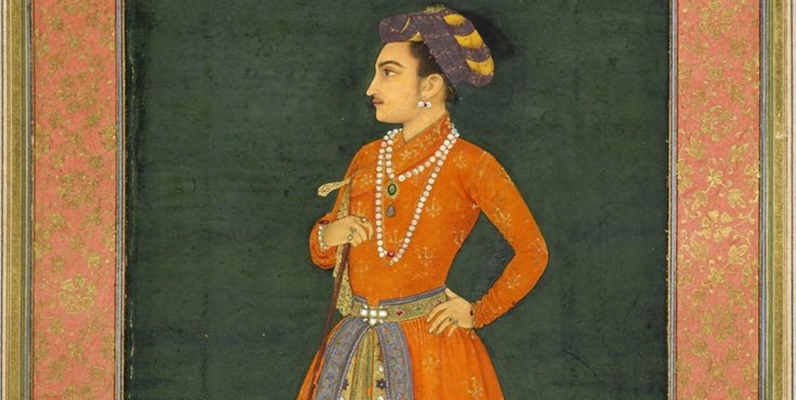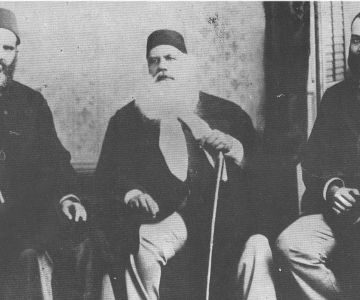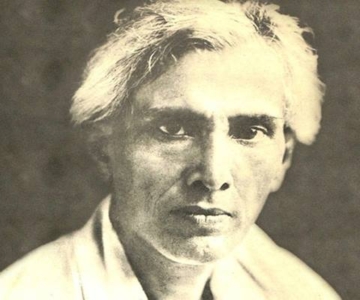Read this excellent piece by Bilal Tanweer published in DAWN, Pakistan on one of my favourite characters:
In another variation of this motif, the severed head is looking back at the vacant spot, while the brush is drawing the self-portrait of the head in blood. In all these versions, the lopped head is an unmistakable symbol of ecstatic transcendence the head is dismembered from the body but is reunited in the subject, in the act of creation, in the contemplation of the beloved.
But whose head is this?
This is Sarmad`s head. This head was lopped off on Aurangzeb Alamgir`s orders in the compound of Jama Masjid Delhi. It survived history`s amnesia by turning its owner into a fountainhead of stories and myths. But despite Sadequain`s reclamation, Sarmad remains a forgotten figure.
This is because the Sarmad who resides in our cultural consciousness is an archetype; his historical person cannot be separated from the fictitious and fantastic stories associated with him. To do so, would run the risk of making this problematic figure simplistic.
Sarmad is problematic mainly because of the paucity of primary accounts on his life and works. He is claimed by all religions (Judaism, Christianity, Islam and Hinduism) and each has narratives to support its claims — no matter how outlandish.
One historian, Nathan Katz, has gone to the extent of counting the number of ruba`iyat in which Sarmad has expressed disdain for each religion (he finds eight `against` Islam; seven against Hinduism; and only one against Judaism). But in all the accounts, there is one predominant defining feature Sarmad`s life is portrayed as a symbol of the vibrant Indian religious syncretism at odds with the puritanical interpretations of religion.
The resulting story runs something like this Sarmad is the mystic who roamed the streets of Delhi without clothes. His mortal enemy is the bigoted king, Aurangzeb Alamgir, and his coterie of accomplices, the scholars of his court, who, for reasons of professional jealousy, crave that Sarmad be put to the sword. Almost all biographical accounts of Sarmad`s life glorify him as an example of religious tolerance while Aurangzeb symbolises the `intolerant religious orthodoxy`. And while this might be useful to propagate a certain viewpoint on religion and politics, it irreparably obscures Sarmad`s life for us.
Therefore, while being mindful of the limitation of the discourse out of which these stories arise, we will treat Sarmad the mystic, Sarmad the poet, Sarmad the historical person, Sarmad the mythical figure who performed miracles, Sarmad the legend, and Sarmad the scholar as one and the same.
Sarmad`s life, as it comes to us, is a collection of a few facts connected by a multiplicity of fantastic stories. Any account of his life can offer little if it does not present these stories as the story of his life.
We will start with the facts, by which is meant events common to most accounts of his life.
Almost all reports of his life agree that Sarmad was born into an Armenian Jewish family in Kashan, Persia. His date of birth is not clear; most recent scholars tentatively put it at 1590 CE, though there are claims for a range of dates between 1590 till 1618 CE. While still in Iran, Sarmad mastered the Judaic texts and moved to study with famous Muslim scholars and later converted to Islam. Abul Kalam Azad, in his essay on Sarmad, states that Sarmad`s knowledge and understanding, especially of Arabic, was at darja-i-kamal — the level of excellence. According to a number of accounts, Sarmad`s adopted Muslim name was Muhammad Sa`id.
Sarmad came to India, arriving at the port city of Thatta as a merchant in 1631. There he fell in love with a Hindu boy, Abhai Chand, who became his constant companion. All accounts present his love for Abhai as the factor that made him
renounce the world. Under Sarmad`s tutelage Abhai learnt Arabic, Persian, and Hebrew and eventually, under Sarmad`s supervision, translated some parts of the Torah into Persian. Sarmad`s wanderings took him from Lahore to Hyderabad Deccan until he landed finally in Delhi where he was already famous as a mystic of great powers.
In Delhi, Sarmad became a companion of the famous sheikh, Syed Hare Bhare. The other important event was his contact with the Mughal prince, Dara Shikoh, who became his devoted disciple. Sarmad famously predicted that Dara would succeed Shahjahan as the successor to the Mughal throne.
This did not turn out to be true, and soon afterward, Aurangzeb claimed the throne and had Dara executed. When Sarmad`s critics pointed this to him, he remarked Che kunam? Shitan qawi ast (`What can I do? Satan is powerful!`). In another tradition, Sarmad claimed that he had predicted the kingdom of the hereafter for Dara.
Sarmad`s is commonly portrayed as being notoriously intolerable of authority. Among those he routinely refused to show respect to was the Emperor himself. Legends have it that Aurangzeb was deeply annoyed by Sarmad`s nudity.
Once as Aurangzeb`s procession was passing through the streets of Delhi, he saw Sarmad sitting by the roadside. The kind ordered the march to halt and demanded the mystic to cover himself. The saint looked at him with wrathful eyes and said, `If you think I need to cover my nudity so badly, why don`t you cover me yourself?` When the emperor lifted the blanket lying on Sarmad`s side, he saw the bloodied heads of all the family members he had had secretly murdered. Bewildered, Aurangzeb looked at Sarmad, who said, `Now tell me, what should I cover — your sins or my thighs?`
It is highly improbable that an emperor tried to cover a naked fakir with his own hands, but such stories are good examples of the spirit and viewpoint which shape the portrayal of Sarmad and Aurangzeb`s supposed encounters.
In another such story, Emperor Aurangzeb`s daughter, Princess Zebunnisa, saw Sarmad making clay houses on the roadside. After paying her respects, she inquired `Are these for sale?`
`Yes,` Sarmad said, `I will sell them for some tobacco.`
Upon receiving the tobacco, Sarmad wrote around the border of one of the clay houses This clay house is sold to Princess Zebunnisa for some tobacco. That night Emperor Aurangzeb saw a dream. He was roaming around in Paradise, when he saw a beautiful palace. When he approached it, he was barred from entering it. Then he noticed that the palace had Princess Zebunnisa`s name written on it.
Sarmad is remembered most of all by the manner of his execution, which took place in 1670 CE. The charges against him are not clear. His minor offences included his public nakedness, use of bhang (marijuana) and his affair with Abhai Chand. But these were not enough ground for execution and some accounts actually mention Aurangzeb himself pointing this out.
However, Sarmad`s main offense was not reciting the full kalima and claiming that the Prophet Muhammad did not ascend the heavens, but that the heavens descended to Muhammad. The religious scholars of Aurangzeb`s court pronounced him a heretic and convinced Aurangzeb to carry out the execution as a binding religious duty.
An age has passed since Mansur`s fame has grown ancient I will figure forth anew the noose`s wine. — Sarmad
Sarmad refused, even under duress, to recite the full kalima. Instead of reciting There is no God but God, and Muhammad is the messenger of God, he insisted on stopping short There is no God. When asked the reason for this, he plainly stated that this was the stage he had reached in his spiritual journey and he would be lying if he said more.
When Sarmad was beheaded, his body seized the lopped head from the ground and ran up the stairs of Jama Masjid threatening to destroy Aurangzeb`s kingdom. In another version of the same incident, the moment Sarmad`s head was severed from the body, it fell to the ground and everyone in the audience heard and saw it recite the full kalima.
A word about Sarmad the poet, and the literature available on him in Urdu. Sarmad was an accomplished Farsi ruba`i poet and while there is dispute about the number of ruba`iyat associated with him, the number ranges between 320 and 340.
A critical edition of his ruba`iyat does not exist. In 2007, Muhammad Saleemur Rahman (Nigarshat Publishers, Lahore) published a collection of his ruba`iyat, Ruba`iyat-e Sarmad, which also contains his prose translations in Urdu. The translations are fairly accurate and true to Farsi originals. Another work in Urdu is by Arsh Malsiyani, Naghma-e Sarmad (Markaz-e Tasnif-o Talif, Nakodar 1964). These are poetic renditions of Sarmad`s ruba`iyat in Urdu.
The writer is a graduate student at Columbia University, New York.



